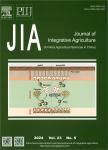Predictive models of drought tolerance indices based on physiological,morphological and biochemical markers for the selection of cotton(Gossypium hirsutum L.)varieties
Predictive models of drought tolerance indices based on physiological,morphological and biochemical markers for the selection of cotton(Gossypium hirsutum L.) varieties作者机构:Colombian Corporation for Agricultural ResearchAGROSAVIA日Espinal 733529Colombia Faculty of Agricultural SciencesNational University of ColombiaBogota D.C 111321Colombia
出 版 物:《Journal of Integrative Agriculture》 (农业科学学报(英文版))
年 卷 期:2022年第21卷第5期
页 面:1310-1320页
核心收录:
基 金:Corporación Colombiana de Investigación Agropecuaria-AGROSAVIA,Universidad Nacional de Colombia–Bogotá,and Agriculture and Rural Development Ministry of Colombia(MADR)who funded this research derived from the research project“New Cotton Varieties with Agroindustrial Characteristics Adapted to Different Agroclimatic Conditions in Colombia”
主 题:drought tolerance tolerance index proline chlorophyll stomatal conductance malondialdehyde yield multivariate analysis
摘 要:The use of tolerant crop varieties is a strategy that mitigates the water deficit effect in a sustainable *** generation of these varieties is more efficient when variables associated with this tolerance have been identified,since they can facilitate the breeding *** study aimed to establish the relationships between water deficit tolerance of four cotton varieties(Nevada-123,Oasis-129,Guatapuri,and Festivalle)and morphological variables(monopodial branches,boll weight,root/shoot ratio,and leaf and root dry matter),physiological variables(relative water content,net photosynthesis,stomatal conductance,electron transport rate,photochemical quenching,photochemical efficiency of PSII,chlorophyll a/b ratio(Chl a/b),C^(12)/C^(13)isotope ratio,and electrolyte leakage),and biochemical variables(contents of sugars,proline,carotenoids,and malondialdehyde).Furthermore,calibrated predictive models of the drought tolerance indices were developed based on the key variables *** this purpose,a pot experiment was established where plants were subjected to a moderate or severe water deficit during the blooming stage for 12 *** stress tolerance index(STI)and mean productivity(MP)were *** the evaluated variables,the differences between well-watered and water deficit plants(Δ)were calculated and ANOVA,partial least squares,Pearson’s correlation,and multiple linear regression analyzes were performed.A model was generated that explained 95% of the STI and was composed of Δmalondialdehyde,Δproline,and Δboll *** MP,the model was comprised of Δstomatal conductance,Δroot/shoot ratio,and ΔChl a/b,and explained 89% of the *** analysis of the assessed variables allowed the identification of key variables and the development of calibrated predictive models that can be used in screening to obtain cotton varieties with different levels of water deficit tolerance.



